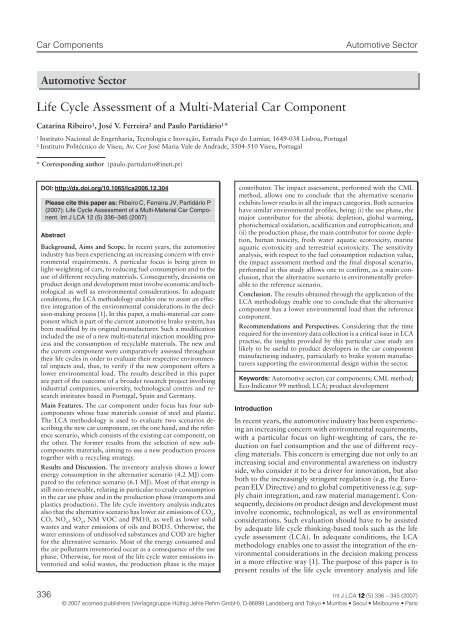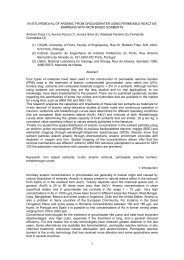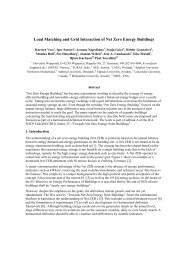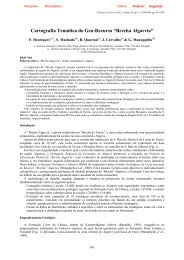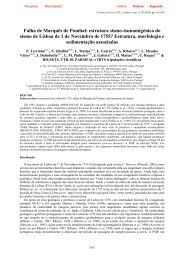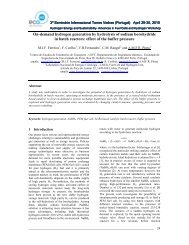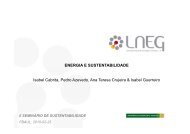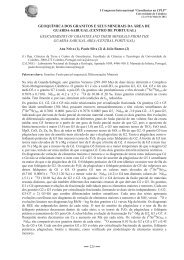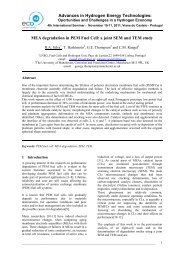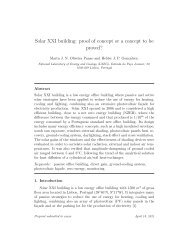Life Cycle Assessment of a Multi-Material Car Component
Life Cycle Assessment of a Multi-Material Car Component
Life Cycle Assessment of a Multi-Material Car Component
- No tags were found...
Create successful ePaper yourself
Turn your PDF publications into a flip-book with our unique Google optimized e-Paper software.
<strong>Car</strong> <strong>Component</strong>sAutomotive SectorAutomotive Sector<strong>Life</strong> <strong>Cycle</strong> <strong>Assessment</strong> <strong>of</strong> a <strong>Multi</strong>-<strong>Material</strong> <strong>Car</strong> <strong>Component</strong>Catarina Ribeiro 1 , José V. Ferreira 2 and Paulo Partidário 1 *1 Instituto Nacional de Engenharia, Tecnologia e Inovação, Estrada Paço do Lumiar, 1649-038 Lisboa, Portugal2 Instituto Politécnico de Viseu, Av. Cor José Maria Vale de Andrade, 3504-510 Viseu, Portugal* Corresponding author (paulo.partidario@ineti.pt)DOI: http://dx.doi.org/10.1065/lca2006.12.304Please cite this paper as: Ribeiro C, Ferreira JV, Partidário P(2007): <strong>Life</strong> <strong>Cycle</strong> <strong>Assessment</strong> <strong>of</strong> a <strong>Multi</strong>-<strong>Material</strong> <strong>Car</strong> <strong>Component</strong>.Int J LCA 12 (5) 336–345 (2007)AbstractBackground, Aims and Scope. In recent years, the automotiveindustry has been experiencing an increasing concern with environmentalrequirements. A particular focus is being given tolight-weighting <strong>of</strong> cars, to reducing fuel consumption and to theuse <strong>of</strong> different recycling materials. Consequently, decisions onproduct design and development must involve economic and technologicalas well as environmental considerations. In adequateconditions, the LCA methodology enables one to assist an effectiveintegration <strong>of</strong> the environmental considerations in the decision-makingprocess [1]. In this paper, a multi-material car componentwhich is part <strong>of</strong> the current automotive brake system, hasbeen modified by its original manufacturer. Such a modificationincluded the use <strong>of</strong> a new multi-material injection moulding processand the consumption <strong>of</strong> recyclable materials. The new andthe current component were comparatively assessed throughouttheir life cycles in order to evaluate their respective environmentalimpacts and, thus, to verify if the new component <strong>of</strong>fers alower environmental load. The results described in this paperare part <strong>of</strong> the outcome <strong>of</strong> a broader research project involvingindustrial companies, university, technological centres and researchinstitutes based in Portugal, Spain and Germany.Main Features. The car component under focus has four subcomponentswhose base materials consist <strong>of</strong> steel and plastic.The LCA methodology is used to evaluate two scenarios describingthe new car component, on the one hand, and the referencescenario, which consists <strong>of</strong> the existing car component, onthe other. The former results from the selection <strong>of</strong> new subcomponentsmaterials, aiming to use a new production processtogether with a recycling strategy.Results and Discussion. The inventory analysis shows a lowerenergy consumption in the alternative scenario (4.2 MJ) comparedto the reference scenario (6.1 MJ). Most <strong>of</strong> that energy isstill non-renewable, relating in particular to crude consumptionin the car use phase and in the production phase (transports andplastics production). The life cycle inventory analysis indicatesalso that the alternative scenario has lower air emissions <strong>of</strong> CO 2 ,CO, NO x, SO x, NM VOC and PM10, as well as lower solidwastes and water emissions <strong>of</strong> oils and BOD5. Otherwise, thewater emissions <strong>of</strong> undissolved substances and COD are higherfor the alternative scenario. Most <strong>of</strong> the energy consumed andthe air pollutants inventoried occur as a consequence <strong>of</strong> the usephase. Otherwise, for most <strong>of</strong> the life cycle water emissions inventoriedand solid wastes, the production phase is the majorcontributor. The impact assessment, performed with the CMLmethod, allows one to conclude that the alternative scenarioexhibits lower results in all the impact categories. Both scenarioshave similar environmental pr<strong>of</strong>iles, being: (i) the use phase, themajor contributor for the abiotic depletion, global warming,photochemical oxidation, acidification and eutrophication; and(ii) the production phase, the main contributor for ozone depletion,human toxicity, fresh water aquatic ecotoxicity, marineaquatic ecotoxicity and terrestrial ecotoxicity. The sensitivityanalysis, with respect to the fuel consumption reduction value,the impact assessment method and the final disposal scenario,performed in this study allows one to confirm, as a main conclusion,that the alternative scenario is environmentally preferableto the reference scenario.Conclusion. The results obtained through the application <strong>of</strong> theLCA methodology enable one to conclude that the alternativecomponent has a lower environmental load than the referencecomponent.Recommendations and Perspectives. Considering that the timerequired for the inventory data collection is a critical issue in LCApractise, the insights provided by this particular case study arelikely to be useful to product developers in the car componentmanufacturing industry, particularly to brake system manufacturerssupporting the environmental design within the sector.Keywords: Automotive sector; car components; CML method;Eco-Indicator 99 method; LCA; product developmentIntroductionIn recent years, the automotive industry has been experiencingan increasing concern with environmental requirements,with a particular focus on light-weighting <strong>of</strong> cars, the reductionon fuel consumption and the use <strong>of</strong> different recyclingmaterials. This concern is emerging due not only to anincreasing social and environmental awareness on industryside, who consider it to be a driver for innovation, but alsoboth to the increasingly stringent regulation (e.g. the EuropeanELV Directive) and to global competitiveness (e.g. supplychain integration, and raw material management). Consequently,decisions on product design and development mustinvolve economic, technological, as well as environmentalconsiderations. Such evaluation should have to be assistedby adequate life cycle thinking-based tools such as the lifecycle assessment (LCA). In adequate conditions, the LCAmethodology enables one to assist the integration <strong>of</strong> the environmentalconsiderations in the decision making processin a more effective way [1]. The purpose <strong>of</strong> this paper is topresent results <strong>of</strong> the life cycle inventory analysis and life336Int J LCA 12 (5) 336 – 345 (2007)© 2007 ecomed publishers (Verlagsgruppe Hüthig Jehle Rehm GmbH), D-86899 Landsberg and Tokyo • Mumbai • Seoul • Melbourne • Paris
Automotive Sector<strong>Car</strong> <strong>Component</strong>scycle impact assessment <strong>of</strong> a car component, which is part<strong>of</strong> a car brake system booster. The case study presented inthis paper is the result <strong>of</strong> a broader R&D project developedby a partnership involving industry, universities, technologicalcentres and research institutes from different Europeancountries (Portugal, Spain and Germany). In this particularcase-study, a multi-material car component is modified byits original manufacturer in order to explore a new multimaterialinjection moulding process where just recyclablematerials will be used. The LCA methodology is used toassess the new and the current car components throughouttheir respective life cycles in order to evaluate the correspondingenvironmental impacts and, thus, verify if the newcomponent has a lower environmental load, and which phaseis contributing more to the global environmental impact.The LCA is an important tool for guiding environmentaldesign improvements in the automotive industry [2] and significantcontributions are already available focusing on theLCA for the automotive sector. In particular, Keoleian et al.1998 have conducted a comparative assessment <strong>of</strong> a multilayerHDPE fuel tank and a steel fuel tank. A major conclusionfor both tank systems was that the use phase accountsfor the majority <strong>of</strong> the energy consumed and that the HDPEfuel tank system is environmentally preferable overall to thesteel tank system [2]. Three air intake manifold designs werealso studied by Keoleian and Kar 2003, using life cycle inventoryanalysis and life cycle cost analysis, underlining onceagain that the use phase accounts for the greatest fraction <strong>of</strong>energy consumed on the whole life cycle, in this particularcase being that the manifold weight is the single, most importantdeterminant <strong>of</strong> life cycle energy [3].1 MethodologyTo evaluate the environmental aspects and potential impactsassociated with the car component under scope, fromraw material acquisition to final product disposal, an LCAmethodology was used based on ISO (International Organizationfor Standardization) recommendations [4–7]. Makinguse <strong>of</strong> the LCA s<strong>of</strong>tware SimaPro 6.01 [8], the environmentalimpact <strong>of</strong> the new and current car component wasassessed using the problem-oriented approach (CML 2baseline 2000) [9]. As an option for a sensitivity analysisapplication, an endpoint-oriented approach (Eco-indicator99) [10] was used.2 Goal and Scope <strong>of</strong> the Study2.1 GoalThe goal <strong>of</strong> the LCA is to identify options for improving theenvironmental performance <strong>of</strong> the car component. The results<strong>of</strong> this study will be used for product and process development.The component manufacturer wants to be ableto analyse the effects <strong>of</strong> changes in its processes, in terms <strong>of</strong>technology, inputs and product composition, on the totalenvironmental impact. This information, in turn, can be usedto prioritise different measures that can be taken to improvethe environmental performance. This LCA does not aim atpublic comparative assertions, so that an expert review willnot be carried out. The study was conducted by INETI, aresearch institute, within a project coordinated by the companyIber-Oleff and including also other companies, technologicalcentres and universities. The commissioner wasfrom the Portuguese Innovation Agency. Interested partiesare mainly part <strong>of</strong> the automotive industry.2.2 Product and scenarios descriptionThe product under scope consists <strong>of</strong> a car component, whichis part <strong>of</strong> the brake system booster. It has 4 sub-components:a spring, a washer, a poppet and a poppet-retainer. For LCApurposes, two cases are addressed: the current product, whichis described by the reference scenario and the new car componentbeing developed, which is described by the alternativescenario. A more detailed description <strong>of</strong> these two scenariosis given below.The reference scenario. In the reference scenario two <strong>of</strong> thesub-components are steel made, one is vulcanised rubber(EPDM) made and the other is based on an engineering plastic(POM). Composition details under this scenario are indicatedin Table 1.Table 1: Reference component composition [11]Sub-components <strong>Material</strong> Weight (g)Spring Wire DIN 2076-D; DIN 17223 2.00Washer Steel St2, LG BK-DIN 1624 5.20Poppet EPDM rubber 5.50Poppet-retainer POM 3.75Steel factory(Holand)Steel factory(Holand)EPDM factory(Germany)POM factory(Germany)Steel Spring factory Spring600 km (Germany) 600 km2.45 km*kg 2.40 km*kgSteel Washer factory Washer700 km (Germany) 700 km9.10 km*kg 7.28 km*kgEPDM600 km16.50 km*kgPoppet factory(Germany)Poppet600 km6.60 km*kgPOM Poppet-ret. factory Poppet-ret600 km (Germany) 600 km11.25 km*kg 4.50 km*kgTotal=16.45The spring is manufactured by rolling and the washer ismanufactured by cutting, and then undergoes a surface treatmentby immersion zinc phosphating. The poppet is manufacturedby injection moulding, followed by vulcanisation,and the poppet-retainer is made by injection moulding. Thecomponent is then obtained by manually assembling thesefour sub-components.Throughout each sub-component production, there is a loss<strong>of</strong> raw materials (steel, EPDM and POM). It is assumedthat the steel and the POM production wastes are recycledand that the EPDM production waste is incinerated. Thefour sub-components and their subsequent assembly areperformed in Germany. The distances and loads involvedduring the transportation steps performed by a 28 t truckare indicated in Fig. 1.Fig. 1: The distances and loads involved in the reference scenarioProduct factory(Germany)Int J LCA 12 (5) 2007 337
<strong>Car</strong> <strong>Component</strong>sAutomotive SectorTable 2: Alternative component composition [11]Sub-components <strong>Material</strong> Weight (g)Spring Wire DIN 2076-D; DIN 17223 3.18Washer PA 6.6 + 30% GF 0.939Poppet TPV 3.48Poppet-retainer PA 6.6 + 30% GF 3.36Total=10.96The alternative scenario. The alternative scenario describesthe car component after improvements, which focused onthe sub-component materials and the production process.In this scenario, the spring is made <strong>of</strong> steel, the poppet ismade <strong>of</strong> a thermoplastic (TPV) and the other subcomponentsare made <strong>of</strong> PA6.6 with 30% <strong>of</strong> glass fibre. The newcomposition is indicated in Table 2.In this particular case, the spring is produced by rolling,while the washer, the poppet and the poppet-retainer aremade in the same mould by multi-material injection moulding.After having inserted the spring in the same mould, thefinal multi-material car component leaves the injection machinealready assembled, thus avoiding the manual assembly<strong>of</strong> the 4 sub-components. As a consequence <strong>of</strong> this integration,the individual production and assembling stepsinvolving the washer, the poppet and poppet-retainer areeliminated. In addition, throughout the whole productionprocess, there is still a loss <strong>of</strong> raw materials. It is assumedthat all these materials are recycled. Finally, for the purpose<strong>of</strong> this analysis, all production process steps are consideredto be performed in Germany, where the distances and loadsused in transportation by a 28 t truck are indicated in Fig. 2.Both the current and the new car components have the samefunction and are made to have the same lifetime <strong>of</strong> the carwhere they are assembled. Moreover, being part <strong>of</strong> the automotivebrake system, both car components must complywith precise technical and assurance standards. Therefore,they are produced in order to fulfil these requirements.At the end <strong>of</strong> its lifetime, it is assumed that the current andthe new car component are shredded and that the metallicsub-components are recycled while plastics are landfilled,as practiced in Europe [12].Steel factory(Holand)PA6.6 + 30%GF factory(Germany)TPV factory(Germany)PA6.6 + 30%GF factory(Germany)Steel Spring factory Spring600 km (Germany) 600 km3.89 km*kg 3.82 km*kgPA 6.6 + 30% GF600 km ; 2.82 km*kgTPV600 km ; 10.45 km*kgPA 6.6 + 30% GF600 km ; 10.02 km*kgProduct factory(Germany)Fig. 2: The distances and loads involved in the alternative scenario2.3 BoundariesThe system boundaries were chosen to include the processesrelated to the production phase, use phase and final disposalphase. The system boundaries for each scenario arerepresented in a simplified way in Fig. 3 and 4. Though thesefigures do not exhibit full details, they contain the main processesstudied. The electricity production, the fuel productionand the transports are presented in the figures in a generalway, considering these processes are associated with alot <strong>of</strong> other processes. Regarding each scenario, the followingdetails are considered.The reference scenario. The system boundaries for the referencescenario include the following main sub-systems:– Steel (55Si7) production (including raw materials)– Spring production by rolling (cold transforming steel)– Low carbon steel (St14) production (including raw materials)– Washer production by cutting– Washer surface treatment by immersion zinc phosphating(including raw materials)– EPDM production (including raw materials)– Poppet production by injection moulding– POM production (including raw materials, but excludingtransport <strong>of</strong> the raw materials)– Poppet-retainer production by injection moulding– <strong>Component</strong> production by manual assembling (consistingjust <strong>of</strong> manual assembling, there is the assumptionthat this process has no environmental impacts)– Fuel production (including raw materials)– Electricity production (including raw materials)– Raw materials transportation from processing site to thesub-component factories– Sub-components' transportation from their respectiveproduction site to the assembling factory– Use phase (car use)– Final disposal phase (steel recycling and landfill <strong>of</strong> EPDMand POM)The alternative scenario. The system boundaries for the alternativescenario include the following main sub-systems:– Steel (55Si7) production (including raw materials)– Spring production by rolling (cold transforming steel)– TPV production (including raw materials)– PA6.6+30%GF production (including raw materials)– <strong>Component</strong> production by multi-injection moulding– Fuel production (including raw materials)– Electricity production (including raw materials)– Steel transportation to the spring factory– Spring and the plastic materials (TPV and PA6.6+30%GF) transportations to the component assemblingsite– Use phase (car use)– Final disposal phase (steel recycling and landfill <strong>of</strong> PA6.6+30%GF and TPV)In both scenarios, the processes regarding auxiliary materialsand packaging are excluded from material processing,sub-components and component manufacturing due to dataunavailability. The steps regarding product distribution arealso excluded.338 Int J LCA 12 (5) 2007
Automotive Sector<strong>Car</strong> <strong>Component</strong>sIronproductionLimestoneproductionNitric acidproductionAmmoniaproductionEthyleneoxideproductionSteelproductionManganeseproductionSiliconproductionHDPEproduction<strong>Car</strong>bonblackproductionSulfuricacidproductionMethanolproductionSteel St14productionSteel 55Si7productionEPDMproductionPOMproductionWasherproduction(cutting)Springproduction(rolling)Poppetproduction(injection m.)Poppet-retainerproduction(injection m.)ZincproductionPhosphoricacidproductionImmersionzincPhosphating<strong>Component</strong>manufacturing(manual assembling)UseMetalsrecyclingPlasticslandfillTransportsElectricityproductionFuelproductionFig. 3: System boundaries <strong>of</strong> the main processes within the reference scenario2.4 Functional unitThe functional unit considered as the base for assessmentand comparative analysis <strong>of</strong> environmental impacts is a singlecomponent over 150,000 km <strong>of</strong> use. That component is assembledin a passenger petrol car with an average mass <strong>of</strong>1,080 kg and for 150,000 km <strong>of</strong> use [12]. The fuel consumption<strong>of</strong> the reference vehicle is 5.87 kg/100 km and theemissions are evaluated according to car (petrol) I – Idemat2001 (SimaPro 6.01) and include combustion and fuel production.The emissions associated just to the fuel combustionare presented in Table 3. The two car components underfocus within the reference and alternative scenarios areproduced in order to have the same life time as the car wherethey are assembled. Over that time period, the componentsdo not undergo any maintenance or repair.2.5 Allocation <strong>of</strong> the use phaseConsidering that the product under analysis is part <strong>of</strong> a carbrake system, it represents a percentage <strong>of</strong> the total car masslifetime and, consequently, it is responsible just for a fraction<strong>of</strong> the environmental impact caused by the whole carduring its lifetime.Table 3: Air Emissions associated with the fuel combustion, over 100 km,<strong>of</strong> a passenger petrol car with a petrol consumption <strong>of</strong> 5.87 kg l/100km [8]SubstanceQuantity (kg)CO 2 20CO 0.58SO 2 0.0029NO x 0.13N 2O 0.004Soot 0.0014VOC 0.083Based both on the fact that this LCA study refers to a lightweightdesign process and that the component mass is lessthan to 20% <strong>of</strong> the vehicle weight, from a scientific point <strong>of</strong>view, the incremental method with its mass orientation is anappropriate method for the allocation <strong>of</strong> a component's fuelconsumption [12]. Then, the fuel consumption <strong>of</strong> the referencecomponent (C ref.comp.) is:C ref.comp.= C ref.veh.x (M ref.comp./ M ref.veh.) x c (1)Int J LCA 12 (5) 2007 339
<strong>Car</strong> <strong>Component</strong>sAutomotive SectorLimestoneproductionNitric acidproductionIronproductionPropyleneproductionHDPEproduction<strong>Car</strong>bon blackproductionManganeseproductionSteelproductionSiliconproductionPolypropyleneproductionEPDMproductionPA6.6productionGlass fiberproductionSteel 55Si7productionTPVproductionPA6.6+30%GFproductionSpringproduction(rolling)<strong>Component</strong>manufacturing(multi-injection m.)UseMetalsrecyclingPlasticslandfillTransportsElectricityproductionFuelproductionFig. 4: System boundaries <strong>of</strong> the main processes within the alternative scenarioAnd the fuel consumption <strong>of</strong> the alternative component(C alt.comp. ) is:C alt.comp. = C ref.veh. x (M alt.comp. / M ref.veh. ) x c (2)WhereC ref.veh. = fuel consumption <strong>of</strong> the reference vehicle (5.87 kg/100 km)M ref.comp = mass <strong>of</strong> the reference component (16.45x10 –3 kg)M ref.veh.= mass <strong>of</strong> the reference vehicle (1,080 kg)M alt.comp. = mass <strong>of</strong> the alternative component (10.96x10 –3 kg)c = fuel consumption reduction value (non-dimensional)According to EUCAR (1998), a value <strong>of</strong> 0.6 for 'c' is consideredthe most representative in automotive LCA studies [12].Using equations (1) and (2), the fuel consumption is obtainedover the life <strong>of</strong> the reference vehicle (0.0804 kg) and the fuelconsumption over the life <strong>of</strong> the alternative component(0.0536 kg).3 <strong>Life</strong> <strong>Cycle</strong> Inventory Analysis3.1 Data type/Data sourcesThe life cycle <strong>of</strong> the car component involves several importantprocesses and a relevant number <strong>of</strong> interested parties(i.e. raw materials manufacturers, sub-components manufacturers,component manufacturer, transportation companies,recyclers and incineration plants). The quantity <strong>of</strong> data is thereforevery high. To have access to the necessary data set, informationfrom project partners (the component manufacturer,for instance), literature and specialized databases are used. Adescription <strong>of</strong> the data sources used is given below.The reference scenario• Production phaseSpring. The spring material is considered equivalent to the'55Si7 I' steel, as defined in Idemat 2001 database (SimaPro6.01). The production process is equivalent to the 'Coldtransforming steel' process as described in Data Archivedatabase (SimaPro 6.01) where a 2% production waste isconsidered based on project partners' information.340 Int J LCA 12 (5) 2007
Automotive Sector<strong>Car</strong> <strong>Component</strong>sWasher. The washer material is considered to be equivalentto the 'St14 I' steel as defined in Idemat 2001 database(SimaPro 6.01), while the washer production process is consideredto be equivalent to the 'Cutting steel shears' process,as described in the Data Archive database (SimaPro 6.01).However, a 20% production <strong>of</strong> waste is considered, as basedupon project partners' information. Regarding the surfacetreatment, data is obtained from the 'Phosphating (Zni) I'process included in Idemat 2001 (SimaPro 6.01).Poppet. The poppet material is considered to be equivalentto the 'EPDM rubber ETH U' as defined in the ETH-ESU1996 database (SimaPro 6.01). The poppet production processis similar to the 'Injection moulding' process, as describedin the Data Archive database (SimaPro 6.01). However,according to project data, the quantity <strong>of</strong> productionwaste considered was 60%, and the electricity consumptionby kg <strong>of</strong> output was 7.6 MJ, which includes the electricityconsumption both for vulcanisation and for injection.Poppet-retainer. The inventory data for the poppet-retainermaterial (POM) was obtained from Chalmers University <strong>of</strong>Technology [13]. The poppet-retainer production process issimilar to the 'Injection moulding' process, as described inthe Data Archive database (SimaPro 6.01) However, thequantity <strong>of</strong> production waste considered was 60% in orderto be closer to project data.The steel waste recycling process is assumed to be equivalentto the 'Recycling ferro metals' defined in the DataArchive database (SimaPro 6.01). Accordingly, an estimatedtransportation distance <strong>of</strong> 0.25tkm/kg <strong>of</strong> waste is used. ThePOM waste recycling process is similar to the activity <strong>of</strong>'Recycling plastics (excl. PVC)', as described in the DataArchive database. In this case, the transportation distanceconsidered is 0.15tkm/kg <strong>of</strong> waste, where POM is to beavoided in the product. The EPDM waste incineration processis equivalent to the activity <strong>of</strong> 'Incineration plastics (excl.PVC)', as defined in the Data Archive database (SimaPro6.01). In this treatment process, all transport distances areconsidered.Transportation distances <strong>of</strong> materials and sub-components,as referred to in Figure 1, were obtained from project data.In addition, it is assumed that such transportation is doneby a 28 tonne truck, which is represented by the 'Truck 28tB250' as defined in the Buwal 250 database (SimaPro 6.01).• Use phaseThe car component is considered to be assembled in a carequivalent to a '<strong>Car</strong> (petrol) I', as defined in Idemat 2001(SimaPro 6.01) and portraying the characteristics describedin section 2.4.• Final disposal phaseThe steel recycling process is assumed to be equivalent tothe 'Recycling ferro metals', as defined in the Data Archivedatabase (SimaPro 6.01). Accordingly, an estimated transportationdistance <strong>of</strong> 0.25tkm/kg <strong>of</strong> waste is used. The plastics(POM and EPDM) landfill process is similar to the activity<strong>of</strong> 'Landfill plastics (excl. PVC)', as described in DataArchive database (SimaPro6.01).The alternative scenario• Production phaseSpring. The spring composition is to considered to be equivalentto the '55Si7 I' steel, which is defined in the Idemat2001 database (SimaPro 6.01). The spring production processis equivalent to the 'Cold transforming steel' process,as described in the Data Archive database (SimaPro 6.01).In addition, a production waste <strong>of</strong> 2% is considered accordingto project data.Washer. The washer composition is considered to be equivalentto the 'PA 66 GF 30 I', which is defined in the Idemat2001 database (SimaPro 6.01). In this moulding process bymulti-material injection, the washer, the poppet and the poppet-retainerare made in the same mould, as the injection <strong>of</strong>each sub-component material is performed in a sequentialmanner. As a consequence, for LCA purposes, the multimaterialinjection moulding process is modelled as consisting<strong>of</strong> 3 single injection moulding processes (regarding theproduction <strong>of</strong> a washer, a poppet and a poppet-retainer, respectively).As far as the washer is concerned, its productionprocess is considered to be similar to the 'Injectionmoulding' process as described in the Data Archive database(SimaPro 6.01). In addition, according to project data,the quantity <strong>of</strong> production waste is assumed to be 60%.Poppet. The TPV composition is assumed to consist <strong>of</strong> 45%PP and 55% EPDM. It is considered that both PP and EPDMare equivalent to 'PP ETH U' and 'EPDM rubber ETH U',respectively, as defined in the ETH-ESU 1996 database(SimaPro 6.01). The poppet production process is assumedto be equivalent to the 'Injection moulding' process that isdescribed in the Data Archive database (SimaPro 6.01).However, according to project data, the quantity <strong>of</strong> productionwaste is assumed to be 60% and the electricity consumption<strong>of</strong> 2.28 MJ per kg <strong>of</strong> output.Poppet-retainer. The poppet-retainer composition is assumedto be equivalent to the 'PA 66 GF 30 I', as defined in theIdemat 2001 database (SimaPro 6.01). Its production processis considered to be equivalent to the 'Injection moulding'process that is described in the Data Archive database(SimaPro 6.01), although, according to project characteristics,a production waste <strong>of</strong> 60% is considered.The steel waste recycling process is assumed to be equivalentto the 'Recycling ferro metals' defined in the DataArchive database (SimaPro 6.01). Accordingly, an estimatedtransportation distance <strong>of</strong> 0.25tkm/kg <strong>of</strong> waste is used. ThePA6.6+30%GF waste recycling process is considered to besimilar to the 'Recycling plastics (excl. PVC)', as describedin the Data Archive database. A transportation distance <strong>of</strong>0.15tkm/kg <strong>of</strong> waste is assumed. The PA6.6+30%GF is consideredas the avoided product. Regarding the TPV wasterecycling process, a similarity with the 'Recycling plastics(excl. PVC)' is considered and, thus, described in the DataArchive database. Accordingly, the transportation distance<strong>of</strong> one kilogram <strong>of</strong> waste is taken as 0.15tkm and, in thiscase, the TPV is the product avoided.Transportation distances, described in Fig. 2, are based onproject data. It is assumed that a 28 tonne truck is usedInt J LCA 12 (5) 2007 341
<strong>Car</strong> <strong>Component</strong>sAutomotive Sectorwhich is equivalent to the 'Truck 28t B250', as defined inthe Buwal 250 database (SimaPro 6.01).• Use phaseThe car component under focus is considered to be assembledin a car equivalent to '<strong>Car</strong> (petrol) I', which is defined inIdemat 2001 (SimaPro 6.01), and having the characteristicsas described in Section 2.4.• Final disposal phaseThe steel recycling process is assumed to be equivalent tothe 'Recycling ferro metals', as defined in the Data Archivedatabase (SimaPro 6.01). Accordingly, an estimated transportationdistance <strong>of</strong> 0.25 tkm/kg <strong>of</strong> waste is used. The plastics(POM and EPDM) landfill process is similar to the activity<strong>of</strong> 'Landfill plastics (excl. PVC)', as described in theData Archive database (SimaPro6.01).3.2 ResultsThe inventory analysis and the subsequent impact assessmenthave been performed using the LCA s<strong>of</strong>tware SimaPro6.01. The energy consumption (MJ/component) throughoutthe lifecycle in each scenario is shown in Fig. 5. In bothscenario conditions, the energy consumption is higher duringthe use phase. This is due to the fuel (petrol) consumptionin this particular phase, which is smaller in the alternativescenario because the alternative component has a lower mass.Regarding the reference scenario, the use phase contributes to66% <strong>of</strong> the total energy consumption through the entirelifecycle. Regarding the alternative scenario, the use phase isresponsible for 64% <strong>of</strong> the whole energy consumed. Duringthe production phase, the energy consumption is comparativelyhigher for the reference scenario. This is due to the higherplastic and steel content, to the higher energy consumptionin the production sub-processes, and to the longer distancestravelled. Finally, the disposal phase has a negative energyconsumption, considering the environmental benefits thatresult from the steel sub-components recycling. As an overviewfor both scenarios, the total energy consumption ob-Fig. 6: <strong>Life</strong> cycle solid wastes generation for reference and alternativescenariosserved through the reference and the alternative scenariolifecycles is 6.1 MJ/component and 4.2 MJ/component, respectively,consisting mostly <strong>of</strong> non-renewable energy.The quantity <strong>of</strong> solid wastes that are generated throughoutthe lifecycle <strong>of</strong> each scenario is shown in Fig. 6. In particular,the solid wastes generated in the use phase are negligiblewhen compared to the production phase. In the productionphase, the reference scenario accounts for the majority <strong>of</strong>solid wastes, mainly due to the POM production. The quantity<strong>of</strong> solid wastes generated in the final disposal phase issimilar in both scenarios, being mainly related to the plasticslandfill. In a global perspective, the reference scenarioaccounts for a solid wastes quantity <strong>of</strong> 20 g/component andthe alternative scenario for 13 g/component.The cumulative life cycle air emissions <strong>of</strong> carbon monoxide(CO), nitrogen oxides (NO x ), sulphur oxides (SO x ), nonmethanevolatile organic compounds (NM VOC) and particulatematter with a diameter under 10 µm (PM 10) arepresented in Fig. 7. Emissions regarding these parametersFig. 5: <strong>Life</strong> cycle energy consumption for reference and alternative scenariosFig. 7: Cumulative life cycle air emissions for reference and alternativescenarios342 Int J LCA 12 (5) 2007
Automotive Sector<strong>Car</strong> <strong>Component</strong>sphase and is basically related with the HDPE production,diesel production and PP production (in the alternative scenario).The PM 10 emissions are also greater in the productionphase for the reference scenario and similar in the productionand use phases for the alternative scenario. Thispollutant concerns the steel production and the production<strong>of</strong> fuel consumed in the use phase.Fig. 8: Cumulative life cycle water emissions for reference and alternativescenariosare higher in the reference scenario when compared to thealternative scenario. The carbon dioxide (CO 2) emissions,both in the reference and in the alternative scenarios, are416 g/component and 274 g/component, respectively. Thisproportion is in agreement with the proportion obtained forthe energy consumption (see Fig. 5) and with the large use<strong>of</strong> carbon-based fossil fuels (petrol and diesel). It could beverified in this study that the use phase accounts for themajority <strong>of</strong> the life cycle air emissions <strong>of</strong> CO, NO x and CO 2 ,since these parameters are mostly related with fuel productionand fuel combustion that occurs in this phase. The SO xemissions are greater for the production phase in both scenariosand are mostly related with electricity production,processes occurring in refineries (like the burning <strong>of</strong> residualoil) and with PA66 production in the alternative scenario.The NM VOC emission is also greater in the productionThe cumulative life cycle <strong>of</strong> waterborne emissions <strong>of</strong> undissolvedsubstances, oils, COD and BOD5 are shown in Fig. 8.The undissolved substances include also suspended substancesand suspended solids. The undissolved substancesand the COD parameters are greater for the alternative scenario.Otherwise, the oils and BOD5 parameters are greaterfor the reference scenario. This study reveals that the productionphase is the dominant source for these pollutantswith the exception <strong>of</strong> BOD5, where the main source is theuse phase due to fuel (petrol) production. The undissolvedsubstance emission is basically related to the crude production(for later plastics production), POM production (in thereference scenario) and to PA6.6 production (in the alternativescenario), and to diesel and electricity production. Forthe oil emission, the crude oil transport and the production<strong>of</strong> diesel are the largest sources. Concerning the COD, it isemitted essentially during EPDM and electricity productionprocesses (for both scenarios) and during the PA6.6 productionprocesses (for alternative scenario).Considering the above inventory results, the alternative scenarioseems to be environmentally preferable to the referencescenario.4 <strong>Life</strong> <strong>Cycle</strong> Impact <strong>Assessment</strong>The results <strong>of</strong> the life cycle impact assessment obtained usingthe problem-oriented approach CML 2000 [8;9] withimpact categories defined at a mid-point level are presentedabioticdepletionglobal warming(GWP100)ozone layerdepletion(ODP)human toxicityfresh wateraquatic ecotox.marine aquaticecotoxicityterrestrialecotoxicityphotochemicaloxidationacidificationeurtrophicationFig. 9: Comparative LCIA results for reference and alternative scenarios using the CML 2 baseline 2000 method/West Europe 1995/CharacterizationInt J LCA 12 (5) 2007 343
<strong>Car</strong> <strong>Component</strong>sAutomotive Sectorabioticdepletionglobal warmingozone layerdepletionhuman toxicityfresh wateraquatic ecotox.marine aquaticecotoxicityterrestrialecotoxicityphotochemicaloxidationacidificationeurtrophicationabioticdepletionglobal warmingozone layerdepletionhuman toxicityfresh wateraquatic ecotox.marine aquaticecotoxicityterrestrialecotoxicityphotochemicaloxidationacidificationeurtrophicationFig. 10: LCIA results for reference scenario using the CML 2 baseline2000 method/West Europe 1995/Characterizationin Fig. 9, 10 and 11. This method led to the conclusion thatthe alternative scenario is environmentally preferable comparedwith the reference scenario. The values obtained forall the impact categories are smaller in the case <strong>of</strong> the alternativescenario.The use phase in the reference scenario is the phase whichhas the greater contribution for the abiotic depletion andglobal warming. That is due mainly to fossil fuels extraction(crude, coal and natural gas) for petrol production, andto CO 2 and N 2 O emissions during the car use. The use phasealso has a main contribution for photochemical oxidation,acidification and eutrophication, which is justified by thegreat quantities <strong>of</strong> CO, SO 2 and NO x emitted as a result <strong>of</strong>petrol production and combustion. For the other impactcategories, the production phase is the main contributor. Thesame conclusions can be drawn for the alternative scenario,which exhibits a similar environmental pr<strong>of</strong>ile (see Fig. 11).5 InterpretationThe use phase has a great contribution to the global environmentalimpact. Therefore, the method used to evaluate theimpact <strong>of</strong> this life cycle phase, and particularly the 'use phase'allocation procedure, is very important. Thus, a sensitivityanalysis was conducted using a different fuel consumptionreduction value (c), in the incremental method. In this study, ac value <strong>of</strong> 0.6 is used as proposed by EUCAR 1998 [12]. Consideringthe existing references to other values, a sensitivityanalysis was performed using the fuel consumption reductionvalue suggested by Keoleian, c=0.438 [2]. In such a case, afuel consumption over the life cycle is obtained <strong>of</strong> 0.0587 kgfor the reference situation and <strong>of</strong> 0.0391 kg for the alternativecomponent, which results in a decrease in environmental impactduring the use phase for both scenarios. Therefore, thereference scenario still has a greater environmental load whencompared to the alternative scenario.Fig. 11: LCIA results for alternative scenario using the CML 2 baseline2000 method/West Europe 1995/CharacterizationTo evaluate the environmental impacts, a sensitivity analysiswas performed using an alternative method, which is accordingto the ISO 14042 recommendation. Eco-indicator 99 [10],as an endpoint-oriented approach, was used for that purpose.Results obtained converge with the conclusions achieved withthe CML method, i.e. the alternative scenario has a lower environmentalimpact than the reference scenario. The alternativescenario exhibits lower results for all the impact and damagecategories considered in this method.The sensitivity <strong>of</strong> the results with respect to the end <strong>of</strong> lifescenario was also tested, taking into account the ELV Directive[14]. It was considered, for both reference and alternativeproducts, that 80% <strong>of</strong> the steel components are recycledand 20% are landfilled and 100% <strong>of</strong> the plastics arelandfilled. The impact assessment led to the same conclusion:the results obtained for the alternative scenario arelower than those obtained for the reference scenario for allthe impact categories. The differences between this final disposalscenario and the studied final disposal scenario arevery small; the highest difference is for fresh water aquaticecotoxicity impact category and is circa 2% and 2.5% forthe alternative and the reference product, respectively.6 ConclusionsBased on the inventory analysis and the impact assessmentresults, the following main conclusions can be drawn:– the changes on washer, poppet and poppet-retainer materialsand the change <strong>of</strong> the production process to amore integrated one (which eliminates some productionsteps) result in a multimaterial car component which isenvironmentally better than the existing one, mainly dueto the reduction in component mass and, consequently,in the reduction in fuel consumption and resources consumption(crude and minerals).344 Int J LCA 12 (5) 2007
Automotive Sector<strong>Car</strong> <strong>Component</strong>s– the use phase is the main contributor for the abiotic depletion,global warming, photochemical oxidation, acidificationand eutrophication.– the production phase has the major contribution forozone depletion, human toxicity, fresh water aquaticecotoxicity, marine aquatic ecotoxicity and terrestrialecotoxicity.– the sensitivity analysis performed in this study allowsone to confirm, as a main conclusion, that the alternativescenario is environmentally preferable when comparedto the reference scenario.Acknowledgements. This study has been performed within the scope<strong>of</strong> the Imatech project – In-Mould Assembling Technology, which wasfinanced by the ADI – Agência de Inovação. The authors would like tothank all the project partners, Iber-Oleff- <strong>Component</strong>es Técnicos emPlástico, SA; TRW Lucas Varity GmbH; Departamento de Engenhariade Polímeros da Universidade do Minho; Centimfe – Centro Técnológicoda Indústria de Moldes e Ferramentas Especiais e Plástico andITA –Instituto Tecnologico de Aragon, for their collaboration in providinginformation and valuable data for inventory purposes.References[1] Curran MA (1996): Environmental <strong>Life</strong> <strong>Cycle</strong> <strong>Assessment</strong>.Mc Graw Hill[2] Keoleian G, Spatari S, Beal RT, Stephans RD, Williams RL(1998): LCA Case Studies, Application <strong>of</strong> <strong>Life</strong> <strong>Cycle</strong> InventoryAnalysis to Fuel Tank System Design. Int J LCA 3 (1)18–28[3] Keoleian GA, Kar K (2003): Elucidating complex design andmanagement trade<strong>of</strong>fs through life cycle design: air intakemanifold demonstration project. J Cl Prod (11) 61–77[4] International Organization for Standards (ISO) (1997): Environmentalmanagement – <strong>Life</strong> cycle assessment – Principlesand framework. ISO 14040, Geneva[5] International Organization for Standards (ISO) (1998): Environmentalmanagement – <strong>Life</strong> cycle assessment – Goal andscope definition and inventory analysis. ISO 14041, Geneva[6] International Organization for Standards (ISO) (2000): Environmentalmanagement – <strong>Life</strong> cycle assessment – <strong>Life</strong> cycleimpact assessment. ISO 14042, Geneva[7] International Organization for Standards (ISO) (2000): Environmentalmanagement – <strong>Life</strong> cycle assessment – <strong>Life</strong> cycleinterpretation. ISO 14043, Geneva[8] SimaPro 6 (2004): Analyst 6.0.1, Pré Consultants[9] CML (2001): An operational guide to the ISO-standards –Part 3: Scientific background (Final report, May 2001).[10] Goedkoop M, Spriensma R (2001): The Eco-Indicator 99-Adamage oriented method for <strong>Life</strong> <strong>Cycle</strong> Impact – The methodologyreport, 3 rd edition[11] Imatech Project (2004): Interim Report – Task T4.2, Junho2004 (in Portuguese)[12] EUCAR (1998): EUCAR-Automotive LCA Guidelines-Phase2. Lynne Ridge, Rover Group Ltd. (Coordinator)[13] CIT Ekologik AB (1998): Chalmers Industriteknik, LCI DataDocumentation Report[14] Directiva 2000/53/CE de 18 de Setembro de 2000, JornalOficial das Comunidades EuropeiasReceived: March 29th, 2006Accepted: December 22nd, 2006OnlineFirst: December 23rd, 2006Int J LCA 3 (1) 18–28 (1998)Application <strong>of</strong> <strong>Life</strong> <strong>Cycle</strong> Inventory Analysis to Fuel Tank System DesignGregory A. Keoleian*, Sabrina Spatari, Robb T. Beal, Robert D. Stephens and Ronald L. Williams* Corresponding author: Gregory A. Keoleian, National Pollution Prevention Center, University <strong>of</strong> Michigan, Ann Arbor,MI 48109-1115, USAAbstract<strong>Life</strong> cycle assessment is becoming an important tool for guidingenvironmental design improvements in the automotive industry.This paper reports the life cycle inventory pr<strong>of</strong>iles fortwo fuel tank systems based on a collaborative effort betweenthe National Pollution Prevention Center at the University <strong>of</strong>Michigan, General Motors Research and Development, and theNational Risk Management Research Laboratory <strong>of</strong> the U.S.Environmental Protection Agency. Two 31 gallon functionallyequivalent fuel tank systems used on a 1996 light duty vehiclewere investigated: a multi-layer HDPE tank with a steel shieldand PVC coated steel straps, and a steel tank with a HDPEshield and painted steel straps. Overall, the HDPE fuel tanksystem is environmentally preferable to the steel tank systembased on the set <strong>of</strong> inventory results presented in this investigation.The life cycle inventory analysis indicated lower energyburdens for the HDPE tank system and comparable solid wasteburdens for both systems. The total life cycle energy consumptionfor the steel and HDPE tank systems were 4.9 GJ and 3.6GJ per tank, respectively. The energy consumption and most<strong>of</strong> the air pollutants inventoried occurred as a consequence <strong>of</strong>the use phase. The solid wastes were generated primarily duringthe material production phase for the steel tank (13 kg)and during the end-<strong>of</strong>-life management phase for the HDPEtank (14 kg). This study also highlights data analysis andmodeling challenges, including manufacturing and use phaseallocation methods.Keywords: Automotive industry, fuel tank, LCI; fuel tank systems,LCI; HDPE, fuel tank, LCI; LCI, automotive industry, fueltank systems; product system design, automotive industry, LCIInt J LCA 12 (5) 2007 345


